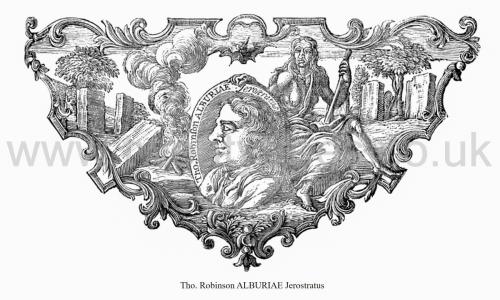Avebury Chapter X
Avebury Chapter X is in Avebury A Temple of British Druids, With Some Others, Described by William Stukeley.
Of the arch-druid's house on Temple-downs, his barrow. Of their places of judicature, and execution. Another Druid's house called old-Chapel towards Winterburn-basset. Another under the Hakpen-hill, over Kennet avenue. Another at Bekamton. Another under Runway-hill. A Kist-vaen in Monkton-fields. Another in Clatford-bottom [Map] by Marlborough. Some general reflexions. They must have been a very great and learned people, that made this work of Abury. The parish of Abury now comprehends many townships, taken in by the extent of the snake. A notion of the snake, and its sacred quality retained by the people, reporting no snake will live within this tract. A conjecture concerning the time of founding this temple, which carries it up to the time of Abraham, or very near it; deduced from the variation of the compass observed there. A mathematical designation of the termination of Bekamton avenue. The major part of Virgil's fifth Æneid is a description of like anniversary games celebrated here, in old times.
THERE is still another of these long archdruids' tumuli at Abury, which leads me to describe a kind of ancient monuments which I meet with here, and near Stonehenge and elsewhere; which I take to be houses of the Druids, or their courts of judicature, or both. The principal of them here, is a remarkable thing, upon the Hakpen-hill east of Abury, near a mile, between it and Rockley. That part of the downs thereabouts is called Temple-downs, and the thing is called old Chapel [Map]. Lord Winchelsea (age 76), Lord (age 39) and Lady Hertford (age 24) and myself were curious in observing it, July 6, 1723. 'Tis a large square, intrenched, 110 druid cubits by 130, like a little Roman camp, with one entrance on the south-west side, towards Abury: for it is posited with accuracy, (as all these works are) from north-east to south-west. The situation of the place is high, and has a descent, quite round three of its sides; the verge of the descent inclosing it like a horseshoe. The entrance is on the side next Abury, on the isthmus of the peninsula (as it were,) on the shortest side of the square, the south-west. It is made of a vallum and ditch; beyond that, a row of flat stones set quite round and pretty close to one another, like a wall. Beyond that, another lesser ditch. There are stones too set on each side the entrance. On the north-west side is a large long barrow 50 cubits in length, with two great stone works upon it. One on the end next the great inclosed place, we have been describing: another stonework towards the other end; which seems to have been a semicircular cove, or demi-ellipsis consisting of five great stones; a Stonehenge cell in miniature, but now in ruins. This probably gave the name of old Chapel [Map] to the place; the barrow likewise has been set quite round with great stones.


In the second stone-work, one stone lies flat on the ground, along the middle line of the barrow. On each side a flat stone stands upright, and two flat stones stand upright at right angles, as wings to 'em. Upon them I suppose other stones were piled as a kist-vaen. Here probably lies the body of the interred. The stones are generally very large, about ten feet long.
The whole I take to have been the palace and interment of an arch-druid, and his tribunal or seat of justice. 'Tis posited exactly enough south-east and north-west. The learned Mr. Rowland, who wrote the history of the Isle of Mona, describes just such works as this in that place, and calls them houses of the Druids.
This place stands near a great cavity called Balmore-pond, which seems to have some regard to this work. 'Tis a pyriform concavity, set with stones on the inside. It answers exactly to old chapel entrance; and the people have a report that there is a vault under it. One would be tempted to think it was a prison, and the pond was the place of executions, being formed theatrically. Otherwise it might be a place of sports and spectacles. 'Tis 150 cubits broad, 180 long, formed like an Amazonian shield.
In a valley between here and Rockley, are nine round barrows of different bulk. And upon all the highest ground thereabouts are an infinite quantity of immense stones, or sarsens, or gray weathers, some of as large dimensions as any at Abury, and lying as thick as leaves in autumn. Some upon the very surface of the ground, some half sunk in; and many deep holes whence stones have been taken, are visible.
If we descend the Hakpen-hill [Map], westward from hence towards Winterburn-basset [Map], upon the declivity of the Hakpen, is another Druid's house, called too Old Chapel. 'Tis a square, double ditched, but small ditches, in the middle a broad oblong square bank. Before it a sort of court, nearly as big as the other. Near it, they say, they have found much old iron and pewter. It seems to have been set round with stones.
There is another of these places in a delightful circular hollow, under the Hakpen-hill, on the west side, hanging over Kennet avenue, just 180 cubits square. It lies on a northern declivity, for coolness as one may judge. The entrance is in the middle of the lowest side. But toward the upper side is another lesser oblong square, what we should call a prætorium in a Roman camp. And to this there was a distinct entrance on the south. 'Tis placed exactly north and south.
In Bekamton town [Map], near the termination of Bekamton avenue, or the snake's tail, is such another place, called Old Chapel or Chapel field. 'Tis full of great stones, many buried under-ground. Richard Fowler, that great depopulator, told me, he demolished one stone standing near the hedge of the pasture. Near it a great stone lies upon the mouth of an old well, as they say, but never remember that it was open, only speak by tradition. This field belongs still to the church.
There is another very pretty place of this sort (for ought I know) between the Wansdike and Via Badonica, running up Runway-hill. 'Tis a charming pleasant concavity. An oblong square, with another lesser, as a prætorium within. In the vallum are many gaps at equal intervals. You will see a large part of it in plate XI. called the model of a camp. 'Tis abusing our time to be tedious, either in descriptions or enquiries, about these matters, 49of which 'tis scarce possible to arrive at any certainty at this time of day. The pleasure arising from them, is in being upon the spot, and treading the agreeable downy turf, crowded with these antiquities; where health to the body and amusement to the mind are mingled so effectually together.
Table XXV. A View near the spot of the Termination of Bekampton avenue July 19. 1723. The Snakes tail.
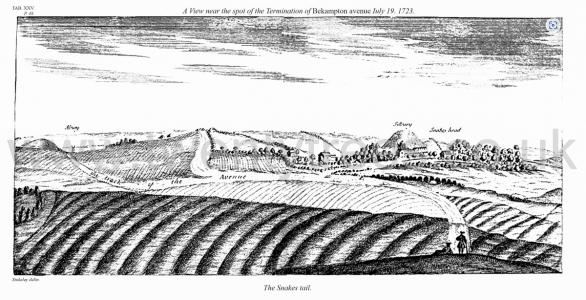
In Monkton-fields, directly north-east from Abury, is a monument [Monkton Fields Long Barrow [Map]] of four stones, which probably is a kist-vaen. I have exhibited a print of it in table XXXVII. These seem to be what Mr. Edward Llwyd calls Kromlechon, or bowing-stones. I believe it was a sepulchral monument, set on a barrow, tho' chiefly now plowed up; and that the great covering-stone is luxated.
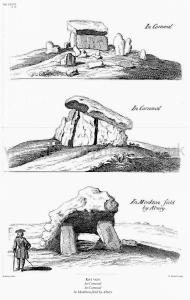 Table XXXVII. Kist vaen In Cornwal, In Cornwal, In Monkton field [Map] by Abury
Table XXXVII. Kist vaen In Cornwal, In Cornwal, In Monkton field [Map] by Abury
Table XXXII, XXXIII, XXXIV, are views of another eminent work [Devil's Den Long Barrow [Map]] of this sort, in Clatford-bottom between Abury and Marlborough, which require no further description.
Table XXXV, two old british urns found at Sunbury by the Thames, shewn at the antiquarian society some years ago. The inscription on the monument of Chyndonax, an archdruid among the Gauls, of which a large account published in french. Father Montfaucon questions the genuineness thereof, but I think his objections are trifling.
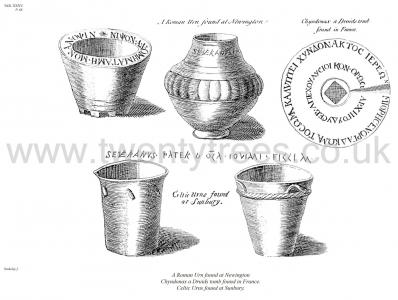 Table XXXV. A Roman Urn found at Newington. Chyndonax a Druids tomb found in France. Celtic Urns found at Sunbury.
Table XXXV. A Roman Urn found at Newington. Chyndonax a Druids tomb found in France. Celtic Urns found at Sunbury.
1723. In table XXXVI, I have etched the bit of the king's bridle found in Silbury-hill [Map], the founder of Abury, in my possession. Underneath is the british urn which I dug up in a barrow on Windmill-hill north of Abury. This plate is consecrated to the memories of Sir Robert Halford, knight, and Charles Tucker, Esq; who were very solicitous in preserving these noble antiquities.
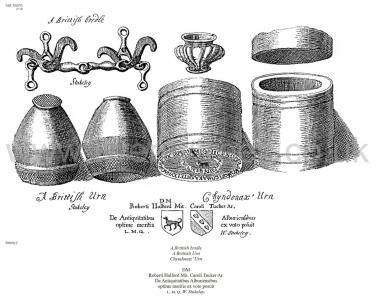 Table XXXVI. A Brittish bridle. A Brittish Urn. Chyndonax' Urn. DM Roberti Halford Mit. Caroli Tucker Ar. De Antiquitatibus Alburiensibus optime meritis ex voto posuit l. m. q. W. Stukeley.
Table XXXVI. A Brittish bridle. A Brittish Urn. Chyndonax' Urn. DM Roberti Halford Mit. Caroli Tucker Ar. De Antiquitatibus Alburiensibus optime meritis ex voto posuit l. m. q. W. Stukeley.
I have given the reader as plain and as concise a description of these works about Abury, as I possibly could. We cannot but make this general reflexion upon the whole: 1. That this temple, with the things belonging to it, when in perfection, must have been the work of a very great and learned people. The kind, manner, and idea of it, shews its extreme antiquity. When we view the ruins of Rome, of Greece, Egypt, Syria, Persia, or the like, we readily enough enter into a notion of the wisdom and flourishing estate of the people that performed them. The like we must do of these british Druids. These very works justify the high reports made concerning them in classic authors. And if we pretend to oppose them by other reports out of like authors, concerning the rudeness and barbarity of the old Britons; the answer is obvious. They speak of different times, or perhaps of different people, new successions from the continent, that drove out the former possessors who performed these works, more northward and westward. The works themselves are an evidence of the genius of the founders. Learning commonly arrives at its height within no long space of time. These works here have a notorious grandeur of taste, a justness of plan, an apparent symmetry and a sufficient niceness in the execution: In compass very extensive, in effect magnificent and agreeable. The boldness of the imagination we cannot sufficiently admire. When this whole area, which is about four miles square, was entirely sacred ground, under the care and custody of the Druids, one of their great seminaries or academies, every where a fine turf, covered over with an infinite variety of barrows, it was a most agreeable scene, and merely a picture.
When one traverses about this ground, an intelligent person will discern abundance of remarkable beauties in the manner and disposition of the temple. The wise Druids knew the internal meaning and purport of this great symbol of the fecundity of the deity, first exerted in producing the second person represented thereby, who with them was the creator of all things. From the supreme proceeded the divine essences equal to himself; but the son of the supreme formed the material words, whence called the mind, the creator, and the wisdom of the father, both by the Druids and us christians. And never since the creation, was so magnificent an idea formed in mortal minds, as this hieroglyphic here before us made in stone-work. This snake of ours may be near three of our common miles in length, justly laid down, its proportions adapted to nature, its sinuosity well represented in huge curves running contrary ways, conduced over several elevations and depressures of ground. Two hills, one on each side the stream running from Abury to Silbury, hide the view of the avenues from each other. So that probably the vulgar then knew not the true figure of the whole, no more than now. But those that approached this place with a purpose of religion, and that understood the mystical meaning thereof, must be extremely affected with it; the greatest picture, no doubt, on the globe of the earth, naturally exciting in their minds that disposition proper for those approaches!
2. I observe that Abury, even now, lays its claim to all the old appendages: the bounds of the parish taking in chiefly all that the snake reaches, and the environs, as Southstreet, West-Kennet, and Bekamton, and part of Winterburn-basset, and Stan-more south of Winterburn-basset, (they say it has been a town;) and Overton-hill, South-downs, West-downs, Cheril-hill, almost to Oldbury-castle.
3. I remark, tho' the people know nothing of the figure of a snake made by the two avenues, yet a notion has been handed down from all times, that gives an obscure hint of the thing, and of the prophylactic virtue in this figure of the snake. For they say, that in all this trail of ground, which we may call the sacred field, there never was a snake seen; and if a snake should be brought hither, it would not live. Nevertheless snakes abound in all the country round, even to Clatford [Map], between Marlborough and here, but never come higher up. This notion, I know not whether 'tis justly founded, but 'tis deeply rooted in the mind of the inhabitants. Pliny has a great deal about the Druids' fondness of snakes, but a little unintelligible, as we find most of what authors have said concerning them. And we must be content at this time, to mark out some obscure traces of things that seem to our purpose, relating to this affair of theirs, which shall be the subject of the next chapters.
4. When we contemplate the manner and disposition of our temple, in regard to its parts in the circle at Abury, and in regard to its position upon the cardinal points, some questions arise in our mind, which we desire a resolution of: Concerning which I believe the hints following will give us some satisfaction. Ever since the world began, in building temples or places of religious assemblies, they have been studious in setting them according to the quarters of the heavens. For they considered the world as the general temple or house of God, and that all particular temples should have a proper regard to it. The east naturally claims a prerogative, where the sun and all the planets and stars arise: this therefore they accounted as the face and front of the world, or universal temple. The north then was considered as the right-hand and great power of the world, the south as the left-hand or lesser power. For when the sun approaches the northern region, passing over the vernal equinoctial, he brings plenty, and the fulness of his fructiferous influence; when he returns to the south, the face of nature languishes in its winter attire. Therefore they thought the polar region not only highest, but of most eminence and effect.
13 May 1724. Table XXVI. A prospect of Silbury hill [Map] from the spring head of the Kennet River. 13 May. 1724.
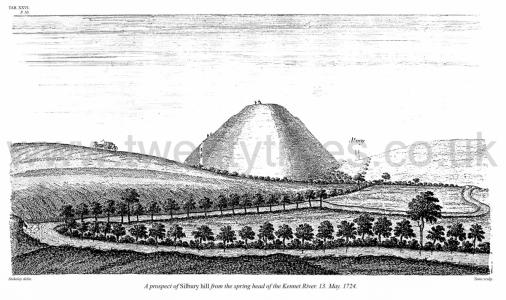
Whence Orpheus: "Thou who holdest the scepter of the pole, venerable on many accounts, the throne of the world in the north."
Psellus says, "the Pandochean power of the world reigns in the north."
Hence Plutarch writes, "That Xenophon says of the Egyptians, they thought that part where the sun rises was the face of the world; the north was its right-hand, where the Nile rises its left." And this helps us to explain several Egyptian antiquities.
But to apply this to our purpose. We cannot but observe, that the whole of Abury temple, or Mausoleum, regarded as a picture, has its upper part to the north, and its face (if we may so speak) toward the east. Thitherward the serpent goes. That way the cove of the northern temple opens; that way the cove of Bekamton avenue; that way the face of Stonehenge temple looks. So that the Druids appear to have the same notions with the other wise men of the oriental ancients.
This therefore shews the reason why they set their temples fronting the east, in all antiquity, and why the coves of our works look that way. As to the two temples at Abury, the northern and southern, included in the great circle, it should seem that the northern one had the preeminence, and was the more sacred of the two. As the cove was the adytum of that temple, so the whole northern temple may be esteemed as the adytum of the whole work, the southern being as the body of it. Solomon's temple, we know, consisted of three parts: the adytum, or holy of holies; the holy place, or sanctuary; the porch. By this means there is a conformity between it and Abury; and to Stonehenge likewise, which has an elliptic adytum, a circular or outer part, and the area. Doubtless the different order of priests, and of religious offices, took up these different parts. And, if we may give our opinion, 'tis natural to think, that because the ring-stone is by the southern temple, there the sacrifices were offered and administered by the lesser orders of priests, around the ambre or central pyramidal. The highest part of religion was to be performed by the archdruid and the upper order of priests before the magnificent cove of the northern temple, together with hymns, incense, musick, and the like.
5. In my account of Stonehenge I suggested a surmise, that the Druids, in laying down these works of theirs, used a compass or magnetic instrument; whence I founded a conjecture concerning the time of building that temple, by observing the variation with a theodolite. As the variation in all the works about Stonehenge is between six and seven degrees to the east of the north, I found it at Abury to be about ten degrees the same way, and as precisely as possible. This will necessarily excite one's attention, as there is less reason to suppose 'tis accidental. The whole work was manifestly designed to be set on the cardinal points of the heavens, but they all vary one way, exactly the same quantity; and 'tis impossible to account for it in any wise, but that they used a magnetic instrument. This is the reason that the neck of the snake on Overton-hill crosses the Roman road running east and west, which would otherwise have been the ground-line of this work.
Thus Kennet avenue enters the town of Abury ten degrees north of the north-west point, which north-west point was the Druids' purpose. The neck of the snake going down from Overton-hill regards Silbury precisely, and their intent was that it should be full west, but 'tis ten degrees north of the west. The meridian line of the whole work passes from Silbury-hill to the center of the temple at Abury, this varies ten degrees to the east from the north-point. The stupendous cove in the northern temple opens ten degrees east of north-east. It was their purpose that it should regard the north-east. The diameter of the great circle of the great stones at Abury, on which the north and south temples are built, was designed to have been set on the line from north-west to south-east, but it verges ten degrees northward; and so of all other particulars. And by this very means we may, at any time, point out the line of the termination of Bekamton avenue, tho' entirely destroyed. For from Silbury-hill, it was designed by the Druids to have been set full west, as Overton-hill full east. Therefore a line marked from Silbury-hill, ten degrees north of the west point, and at the proper length of the avenue, being 4000 cubits, an eastern mile, determines the spot where Bekamton avenue ended. That spot is south of the square inclosure going up to Cheril-hill, where Silbury-hill bears ten degrees south of east, where Abury steeple bears twenty-five degrees west of south-west. From Silbury-hill you mark it by the line that goes to Oldbury camp, on the left hand of Cheril-hill. In that line was the termination of Bekamton avenue; it being the intention of the Druids to place the founder's tumulus or mausoleum of Silbury-hill in the middle, between the two ends of the avenue, the head and tail of the snake, upon the east and west line, and exactly south of the center of the great circle at Abury. This whole work therefore was properly the mausoleum, or made, as it were, one tumulus over the founder. A prophylactic formed by the great symbol of the deity, guarded the ashes of the deceased hero. And from this custom in mythologic times, they invented the notion of a snake being the genius of departed heroes; or of such being turned into snakes and the like, as is said of Cadmus, and many more.
Thus Virgil describing Æneas celebrating the anniversary of his father's death, at his tumulus in Sicily, recites the ancient rites practised at these places and on these occasions, and introduces a snake creeping out of the adytum of the tumulus, passing by the altars and holy utensils, and retiring again, in Æneid V.
——Adytis cùm lubricus anguis ab imis [Adytis with a slippery snake from the bottom]
Septem ingens gyros, septena volumina traxit, [He drew seven huge circles, seven volumes]
Amplexus placidè tumulum———— &c. [A peaceful embrace of the mound]
Hoc magis inceptos genitori instaurat honores, [This establishes the honors of the benefactor more,]
Incertus geniumne loci, famulumne parentis [Uncertain whether he was a genius of the place, or a servant of his parent]
Esse putet [It might be]——
Much might I recite to our purpose out of the ancient commentators on this passage, to which I refer the inquisitive. From the word adytis we may be apt to conclude the tomb of Anchises had a cove built upon it, as that we described at Rowldrich. But to return.
I apprehend the reader will scarce excuse me, if I make not some inference from that observation of the variation of the needle here from the cardinal points. Indeed in these works of antiquity, I would be as temperate as possible in multiplying conjectures; and to nothing more can I pretend in this case, and that too but in gross, for we want sufficient data. A future age may pronounce with more certainty, when we know the entire revolution of the circle of the magnetic variation.
11 Jul 1723. Table XXVII. Silbury Hill [Map] July 11. 1723. A. The Roman road. B. the Snakes head or hakpen.
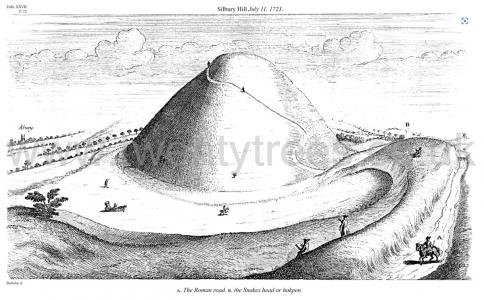
Dr. Halley supposes the whole period is performed in about the space of 700 years. I am sufficiently satisfyed from considering the different effect of the weather between Abury and Stonehenge, the great diversity in the manner of the works, and some other considerations, that Abury must be above 700 years prior in time to Stonehenge. But if we take two entire revolutions, 1400 years, and set it 460 years before the christian æra, the supposed time of the building of Stonehenge, it brings us, in Usher's chronology, which, I take to be the best, to the year of the death of Sarah, Abraham's wife, which happened in the summer time of the 1859th year before Christ. This was a little before the time of Inachus.
By the best light I can obtain, I judge our Tyrian Hercules made his expedition into the ocean, about the latter end of Abraham's time: and most likely 'tis, that Abury was the first great temple of Britain, and made by the first Phœnician colony that came hither; and they made it in this very place on account of the stones of the gray-weathers, so commodious for their purpose.
Usher makes this retirement of the Hycsi, or royal pastors out of Egypt, which was done by our Hercules, to be 34 years after that date. But my numbers make it somewhat later.
Tho. Robinson ALBURIAE Jerostratus
